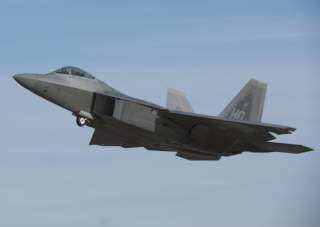5 Ways the U.S. and China Could Stumble Into War
World War III may not be as unlikely as you think.
Sadly, the possibility of a U.S.-China clash in the air is still a real possibility. Back in August of last year, a Chinese jet passed dangerously close to a U.S. P-8 Poseidon surveillance plane. U.S. officials at the time explained that “The Chinese jet … passed the nose of the P-8 at 90 degrees with its belly toward the P-8 Poseidon, we believe to make a point of showing its weapons load out... ” Officials also noted that the Chinese “flew directly under and alongside the P-8, bringing their wingtips … to within 20 feet and then conducted a roll over the P-8, passing within 45 feet.” What if such an incident had turned deadly?
5. Finally...Don’t Forget Taiwan
While tensions between the PRC and the ROC have certainly dropped considerably since the election of President Ma in 2008, there is no guarantee that Beijing may begin to exert pressure seeking the return of its so-called “renegade province.” In fact, Chinese president Xi Jinping alluded to such a possibility, stating, “the issue of political disagreements that exist between the two sides must reach a final resolution, step by step, and these issues cannot be passed on from generation to generation.”
So how does Taiwan play into the possibility of a U.S.-China war? Simple. As a recent report from the always-smart D.C.-based Center for Strategic and Budgetary Analysis (CSBA) explains, the dynamics of PRC-ROC tensions have not changed:
Despite atmospheric improvements in cross-strait ties...the fundamental nature of the dispute has not changed. Beijing still refuses to renounce the use of force as a means of reunification, and China’s steady, methodical build up of missile and air assets aimed at Taiwan serves as a constant and sobering reminder...At the same time, a series of polls indicate that a vast majority of the Taiwanese population continues to reject unification. While both sides’ official positions remain unaltered, the cross-strait military balance has moved decisively in China’s favor....Two decades of annual double-digit growth in Chinese military expenditures have resulted in Beijing acquiring a wide margin of conventional superiority over Taiwan, leading to growing concerns that it may no longer be able to withstand a large-scale PRC assault against its territory and raising the specter of a forcible annexation before U.S. forces could intervene.
There is also the very real possibility that a change of leadership in Taiwan, especially if a candidate from the Democratic Progressive Party (DPP) were to win the 2016 election, could ratchet up tensions—especially if they were to cool efforts to further tie Taiwan to the Chinese mainland. One could easily see Beijing begin to raise the stakes with Taipei—pushing for the resolution of what it has stated many times as one of its most important “core interests.” Clearly, Washington would be concerned over such a trend that could quickly create a crisis in U.S.-Chinese relations. If China were to forcibly attempt to reunite with Taiwan using kinetic force or an outright invasion, it seems some form of a U.S.-China conflict would be all but guaranteed.
Conclusion
Nothing consumes my intellectual bandwidth more than the possibility of a U.S.-China war. While the idea of such a clash seems remote, the number of pressure points that could spark such a conflict are too many to outright rule out such a possibility. All the more reason why both sides need to work towards a way to reduce tensions that could lead to kinetic conflict.
Thankfully, over the last several months, there has been a reason to be hopeful that some of the pressure points listed above might become less of a concern in the future. In November of 2014, the United States and China signed two memorandums of understanding (MOUs) that should help at least with regard to near incidents in the air and sea. As Peter Dutton neatly explained in these pages several weeks back, the “MOUs help reduce the risk of crisis...” However, Dutton also notes “they will not eliminate it, because they do not eliminate the divergent security interests that are at the root of the crises. And even as they improve understanding, such insight is no replacement for respect for power.”
Clearly, the United States and China have many reasons to press forward with what has been over the long term a very successful relationship, despite recent tensions—over $550 billion in bilateral trade alone is just one of many examples. Yet, as Graham Allison explained in these very pages, “when a rapidly rising power rivals an established ruling power, trouble ensues. In 11 of 15 cases in which this has occurred in the past 500 years, the result was war.” Just that fact alone should force policy makers in both Washington and Beijing to work towards avoiding what Allison calls the “Thucydides’s Trap.” What could happen if we don’t is simply too awful to imagine.
Harry J. Kazianis serves as Editor of RealClearDefense, a member of the RealClearPolitics family of websites. Mr. Kazianis is also a Senior Fellow for Defense Policy at the Center for the National Interest (non-resident) and a Senior Fellow at the China Policy Institute (non-resident). He is the former Executive Editor of The National Interest and former Editor of The Diplomat. Follow him on Twitter: @grecianformula.
Image: Flickr/Official U.S. Air Force/CC by-nc 2.0

